I have data of the size of 200 individuals of a particular plant species. But the size was measured in an indirect way, counting the number of leaves (discrete data), monthly during a total of 14 months. The germination, growth and death of the plants are very irregular, with some plants having a long life span, other dying quickly, and also the germination in time is irregular: new plants kept germinating during all the study period and being incorporated into the study. Here is an example of my data (numbers inside cells refer to the number of leaves):
| Month.1 | Month.2 | Month.3 | Month.4 | Month.5 | Month.6 | Month.7 | |
|---|---|---|---|---|---|---|---|
| plant.1 | 3 | 21 | 15 | - | - | - | - |
| plant.2 | - | 7 | 14 | - | - | - | - |
| plant.3 | - | 8 | 12 | 10 | - | - | - |
| plant.4 | - | - | 1 | 3 | 5 | - | - |
| plant.5 | - | 3 | 6 | 18 | 13 | 4 | - |
| ..... | ... | ... | ... | ... | ... | ... | ... |
Following Shibaprasadb's suggestion, here is a subset of my data, already converted to long format:
df <- dput(df)
structure(list(plant = c(1L, 1L, 1L, 1L, 1L, 2L, 3L, 3L, 4L,
4L, 4L, 4L, 4L, 4L, 4L, 28L, 29L, 29L, 29L, 30L, 31L, 32L, 32L,
32L, 32L, 32L, 62L, 62L, 63L, 64L, 65L, 65L, 65L, 65L, 66L, 67L,
67L, 67L), month = c(4L, 5L, 6L, 7L, 8L, 4L, 7L, 8L, 2L, 3L,
4L, 5L, 6L, 7L, 8L, 7L, 6L, 7L, 8L, 6L, 7L, 4L, 5L, 6L, 7L, 8L,
5L, 6L, 6L, 6L, 5L, 6L, 7L, 8L, 8L, 2L, 3L, 4L), time = c(0L,
1L, 2L, 3L, 4L, 0L, 0L, 1L, 0L, 1L, 2L, 3L, 4L, 5L, 6L, 0L, 0L,
1L, 2L, 0L, 0L, 0L, 1L, 2L, 3L, 4L, 0L, 1L, 0L, 0L, 0L, 1L, 2L,
3L, 0L, 0L, 1L, 2L), leaves = c(6L, 18L, 9L, 24L, 6L, 12L, 6L,
6L, 63L, 66L, 15L, 9L, 15L, 21L, 12L, 12L, 3L, 42L, 12L, 9L,
3L, 15L, 21L, 18L, 27L, 15L, 21L, 36L, 24L, 21L, 3L, 12L, 18L,
6L, 3L, 15L, 3L, 3L), tray = c(1L, 1L, 1L, 1L, 1L, 1L, 1L, 1L,
1L, 1L, 1L, 1L, 1L, 1L, 1L, 3L, 3L, 3L, 3L, 3L, 3L, 3L, 3L, 3L,
3L, 3L, 7L, 7L, 7L, 7L, 7L, 7L, 7L, 7L, 7L, 7L, 7L, 7L), soil_nutrient = c(62.4,
71, 13.6, 37.6, 13.8, 62.4, 37.6, 13.8, 47.6, 51.8, 62.4, 71,
13.6, 37.6, 13.8, 25.4, 14.2, 25.4, 17, 14.2, 25.4, 51.6, 72.6,
14.2, 25.4, 17, 148.2, 29.4, 29.4, 29.4, 148.2, 29.4, 103.6,
122.4, 122.4, 116.2, 141, 117.6), watering = c(81.6, 89, 10.6,
57.8, 1.2, 81.6, 57.8, 1.2, 46, 48.6, 81.6, 89, 10.6, 57.8, 1.2,
57.8, 10.6, 57.8, 1.2, 10.6, 57.8, 81.6, 89, 10.6, 57.8, 1.2,
89, 10.6, 10.6, 10.6, 89, 10.6, 57.8, 1.2, 1.2, 46, 48.6, 81.6
), UV_treatment = c("n", "n", "n", "n", "n", "n", "n", "n", "n",
"n", "n", "n", "n", "n", "n", "n", "n", "n", "n", "n", "n", "n",
"n", "n", "n", "n", "n", "y", "y", "y", "n", "y", "n", "n", "n",
"n", "n", "n")), class = "data.frame", row.names = c(NA, -38L
))
df
plant month time leaves tray soil_nutrient watering UV_treatment
1 1 4 0 6 1 62.4 81.6 n
2 1 5 1 18 1 71.0 89.0 n
3 1 6 2 9 1 13.6 10.6 n
4 1 7 3 24 1 37.6 57.8 n
5 1 8 4 6 1 13.8 1.2 n
6 2 4 0 12 1 62.4 81.6 n
7 3 7 0 6 1 37.6 57.8 n
8 3 8 1 6 1 13.8 1.2 n
9 4 2 0 63 1 47.6 46.0 n
10 4 3 1 66 1 51.8 48.6 n
11 4 4 2 15 1 62.4 81.6 n
12 4 5 3 9 1 71.0 89.0 n
13 4 6 4 15 1 13.6 10.6 n
14 4 7 5 21 1 37.6 57.8 n
15 4 8 6 12 1 13.8 1.2 n
16 28 7 0 12 3 25.4 57.8 n
17 29 6 0 3 3 14.2 10.6 n
18 29 7 1 42 3 25.4 57.8 n
19 29 8 2 12 3 17.0 1.2 n
20 30 6 0 9 3 14.2 10.6 n
21 31 7 0 3 3 25.4 57.8 n
22 32 4 0 15 3 51.6 81.6 n
23 32 5 1 21 3 72.6 89.0 n
24 32 6 2 18 3 14.2 10.6 n
25 32 7 3 27 3 25.4 57.8 n
26 32 8 4 15 3 17.0 1.2 n
27 62 5 0 21 7 148.2 89.0 n
28 62 6 1 36 7 29.4 10.6 y
29 63 6 0 24 7 29.4 10.6 y
30 64 6 0 21 7 29.4 10.6 y
31 65 5 0 3 7 148.2 89.0 n
32 65 6 1 12 7 29.4 10.6 y
33 65 7 2 18 7 103.6 57.8 n
34 65 8 3 6 7 122.4 1.2 n
35 66 8 0 3 7 122.4 1.2 n
36 67 2 0 15 7 116.2 46.0 n
37 67 3 1 3 7 141.0 48.6 n
38 67 4 2 3 7 117.6 81.6 n
- plant = the identification number of each individual plant.
- month = the month in which the plant germinated.
- time = similar to month, but each plant starting from zero.
- leaves = number of leaves of each indivial plant.
- tray = the tray in which each plant was; there were 10 trays in all, each tray containing a different type of soil.
- soil_nutrient = the total amount of nutrients of each tray in each month.
- watering = the amount of water added to each tray in each month.
- UV_treatment = an aggresive UV treatment that we are interested to explore its effect on the plants.
I'm interested in checking if there is some pattern in their growth, I mean if they first show an increase in the number of leaves, if they then get stable, and if they suddenly die or gradually decrease the number of leaves before dying.
I've been looking for phenology analysis in R, but what I've found so far is mainly related to climate change, global parameters, etc. On the other hand, growth analysis considering time series is focused on a long sequence of data of a particular variable, not several individuals.

